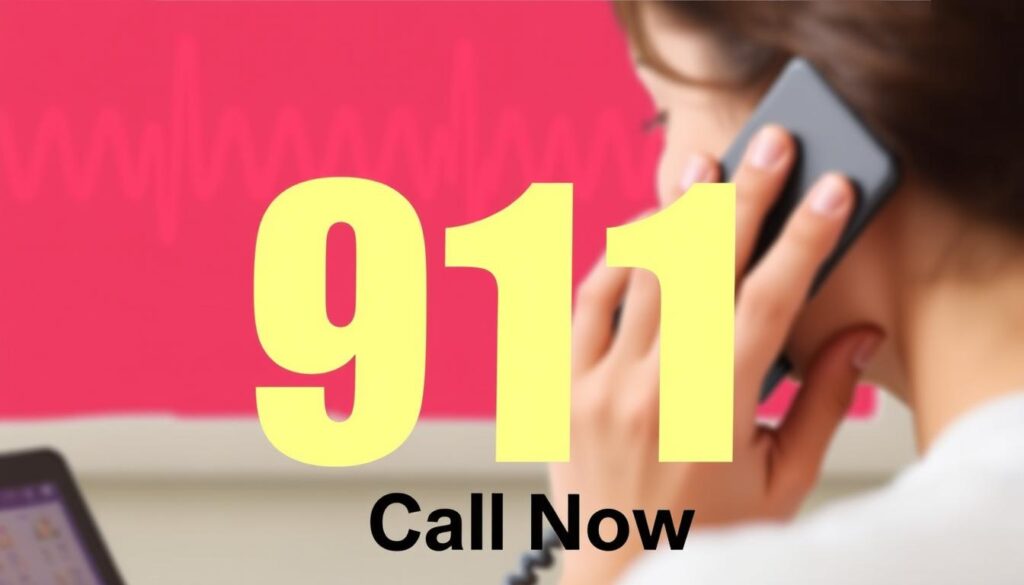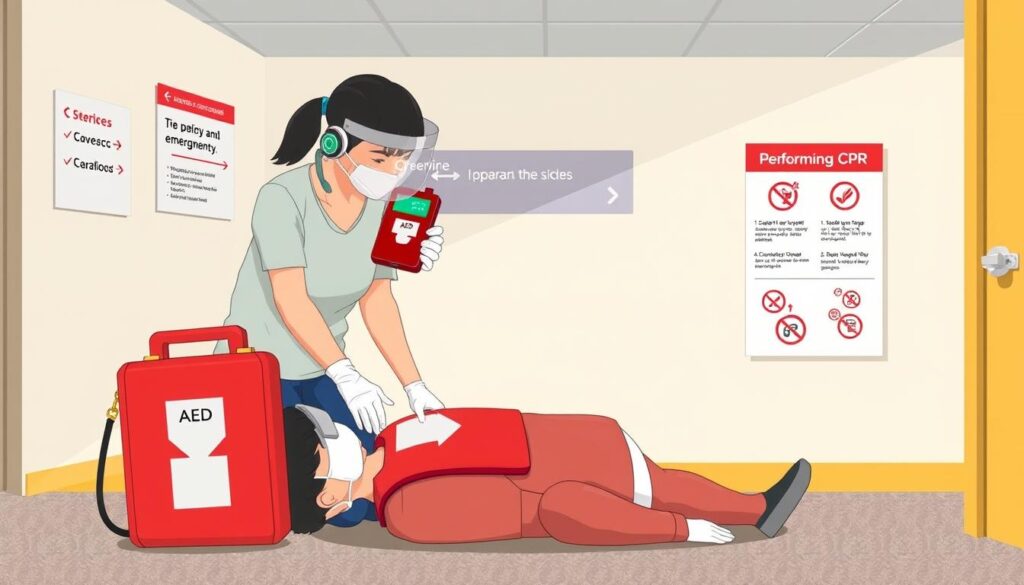When a heart attack happens, every second counts. We can’t stop a heart attack right away, but quick action can save lives. So, what do you do if you or someone you know is having a heart attack? Knowing what to do could be a lifesaver.
Key Takeaways:
- Approximately half of heart attack victims die within the first hour due to delays in treatment.
- Calling 911 immediately is the single most important step to increase the chances of survival.
- CPR and AED use can significantly boost survival rates for sudden cardiac arrests.
- Prompt medical intervention is crucial to restore blood flow and prevent permanent heart damage.
- Recognizing the subtle signs of a heart attack and taking quick action can be life-saving.
Recognize the Symptoms of a Heart Attack
Knowing the signs of a heart attack is key to saving lives. Common signs include chest pain, shortness of breath, and other symptoms like nausea and lightheadedness.
Chest Discomfort and Pain
Chest discomfort is a well-known heart attack sign. It feels like pressure, fullness, or squeezing pain that lasts or comes and goes. This pain can spread to the arms, back, neck, stomach, teeth, or jaw.
Shortness of Breath
Feeling short of breath without any clear reason is another sign of a heart attack. This is very serious and should not be ignored.
Additional Symptoms Like Nausea, Lightheadness
Women may also feel nausea, lightheadedness, or back pain during a heart attack. These signs can be subtle, making it harder to realize the danger.
Pay attention to any strange feelings or changes in your body. This can help you spot the early signs of a heart attack. Getting medical help right away is key to survival and recovery.

“Most people who succumb to fatal heart attacks pass away within the first two hours of showing signs and symptoms.”
| Symptom | Description | Gender Differences |
|---|---|---|
| Chest Discomfort | Feeling of pressure, fullness, or a squeezing pain that lasts for more than a few minutes or goes away and comes back | Both men and women can experience chest discomfort |
| Shortness of Breath | Unexplained shortness of breath, with or without chest discomfort | Both men and women can experience shortness of breath |
| Additional Symptoms | Nausea, lightheadedness, back pain | Women are more likely to experience these additional symptoms |
Knowing the signs of a heart attack is vital for quick action and better survival chances. By spotting signs like chest pain, shortness of breath, and nausea, people can act fast and get emergency help when needed.
Call 911 Immediately
If you or someone you’re with is having chest pain or other signs of a heart attack, act fast. The key step is to call 911 immediately. Emergency medical services (EMS) know how to save lives on the way to the hospital. They can even bring someone back if their heart stops.
Calling 911 means emergency responders can start helping up to an hour before you would get to the hospital on your own. Every 40 seconds, someone in the United States has a heart attack (CDC). So, quick action is vital.
Doctors call a heart attack a myocardial infarction. It usually happens because of coronary artery disease (CAD). If a coronary artery is fully blocked, it’s called an ST-elevation myocardial infarction (STEMI). If it’s only partly blocked, it’s a non-ST-elevation myocardial infarction (NSTEMI).
“Calling 911 immediately upon suspecting a heart attack can result in emergency medical services staff beginning treatment up to an hour sooner than if the individual were to go to a hospital by car.”
Every year, 350,000 out-of-hospital cardiac arrests happen in the United States. Quick action can greatly increase the chances of saving a life. By doing Hands-Only CPR to the beat of “Stayin’ Alive,” you could double or even triple a victim’s chance of survival.

Take Aspirin and Prescribed Medications
If you’re having a heart attack, act fast. Start by chewing an aspirin. This can thin your blood and lessen the damage. But, only take aspirin if told to by emergency services. It might not be right for all strokes.
Also, if you have prescribed medications for chest pain, take them. Or make sure you’ve already taken them while waiting for help. Medicines like nitroglycerin can ease the pain and discomfort of a heart attack.
Chew an Aspirin to Thin Blood
Aspirin is often given to those who’ve had a heart attack or stroke. It makes blood thinner, stopping more clots and lessening heart damage. But, only take it if a doctor says so, as it’s not for all strokes.
Take Nitroglycerin for Chest Pain Relief
If you have nitroglycerin for chest pain, use it or make sure you’ve taken it. It helps ease the pain and discomfort of a heart attack. This makes waiting for help easier.
“Aspirin therapy is not recommended for individuals who have never had a heart attack or stroke, particularly if they are over 70 years old. People with diabetes without a history of heart attack or stroke may not require aspirin therapy unless specifically recommended by their healthcare provider.”

Aspirin and prescribed medicines are key in handling a heart attack. But, always call 911 quickly and follow what the emergency services say. Doing the right things fast can greatly improve your chances.
Prepare for Emergency Response
When someone is having a heart attack emergency, act fast. Make sure the area is ready for paramedics. If the person is inside, open the doors to let the medical team in quickly. This quick action is key to saving time and helping the patient get help right away.
Also, loosen any tight clothes like neckties or belts. This makes it easier for the person to breathe and helps the responders check their condition. Every moment is crucial in a heart attack situation, so being ready is vital.

By doing these things, you can help prepare for the heart attack emergency. This ensures the patient gets the fast and full care they need. Quick actions and a ready environment can really change the outcome in a cardiac emergency.
How to Stop a Heart Attack in Progress?
Stopping a heart attack by yourself is not possible. The best action is to get emergency medical help right away.
Heart attacks happen when a blockage stops the heart from getting enough oxygen-rich blood. According to the CDC, someone in the United States has a heart attack every 40 seconds. Quick action is key to avoid lasting heart damage and save lives.
“There is no fast way to stop a heart attack without seeking emergency medical treatment at a hospital.”
Even though you can’t stop a heart attack, you can help improve the situation:
- Call 911 immediately. Emergency responders can give you life-saving treatments like clot-busting drugs or procedures to open blocked arteries.
- Chew an aspirin, if you have it. Aspirin makes the blood thinner and can reduce blood clots.
- Take any heart medicines you’ve been prescribed, like nitroglycerin, to ease chest pain.
- Open doors and remove tight clothing to make it easier for emergency workers to get to you.
Acting quickly and getting professional help is the best way to survive a heart attack. Trying to stop it by yourself is risky and shouldn’t replace calling 911 or getting immediate care.
Understanding Treatment Options
At the hospital, doctors will quickly figure out the type of heart attack and start the right treatment. This could be clot-busting drugs, angioplasty to clear blocked arteries, or stenting to keep arteries open and improve blood flow.
The faster these treatments start, the less damage to the heart and the better the chance of saving a life. That’s why calling 911 and rushing to the hospital is so important when you’re having a heart attack.
Understand Treatment Options
When a heart attack happens, every second counts. Quick medical help is key to lessen heart muscle damage and save lives. The main treatments are clot-busting medications and angioplasty with stenting.
Clot-Busting Medications
Doctors might give thrombolytic or clot-busting medications to break down the clot causing the heart attack. These drugs dissolve the clot, letting blood flow back to the heart. Aspirin is often the first step, making the blood thinner to stop more clotting.
Angioplasty and Stenting
For serious cases, doctors might do a percutaneous coronary intervention (PCI), or angioplasty. This means using a balloon to open the blocked artery. Then, a stent is put in to keep the artery open and help blood flow better to the heart.
| Treatment | Description | Advantages |
|---|---|---|
| Clot-Busting Medications | Drugs that dissolve blood clots | Restores blood flow quickly |
| Angioplasty and Stenting | Procedure to open blocked arteries | Improves long-term blood flow |
The treatment depends on the heart attack’s type and severity, and the patient’s health. Working together with the medical team is key for the best results.
Learn CPR and AED Use
When a heart attack happens, every second is key. CPR is a vital step in saving lives. It keeps blood and oxygen flowing until help arrives. By doing chest compressions and breathing, CPR can keep someone alive until a defibrillator is used.
AEDs are devices that can fix heart rhythms by giving a shock. They are becoming more common in public places. This makes them a key tool for saving lives in cardiac emergencies.
The Importance of CPR and AED Training
The American Heart Association says CPR can increase survival chances for sudden cardiac arrests outside hospitals to 80%. But, only 10-12% of people make it through such events. This shows how crucial CPR and AED training is. It helps bystanders act fast and with confidence in emergencies.
Administering CPR and Using an AED
- Call 911 or the local emergency number right away.
- Start hands-only CPR with 30 chest compressions at 100-120 per minute.
- If you have an AED, turn it on and follow the voice to apply the pads and give a shock if told to.
- Keep doing 30 chest compressions with two breaths (for those who know full CPR) until help comes or the AED says the heartbeat is normal.
Learning CPR and AED skills can be the difference between life and death in a heart attack. By knowing these skills, you can save a life and be a key part of the “chain of survival.”
| CPR and AED Facts | Statistics |
|---|---|
| Sudden cardiac arrests outside of a hospital setting | Only 10-12% of individuals survive |
| Survival rate with prompt and effective CPR | Can reach up to 80% |
| Annual sudden cardiac arrests in children and teenagers | Approximately 23,000 |
Preventive Measures for Heart Attacks
Keeping a healthy lifestyle can greatly lower the risk of a heart attack. By adding these steps to your daily life, you can protect your heart. This way, you can prevent heart attacks before they happen.
Maintain a Healthy Diet
Eating foods full of nutrients is key for a healthy heart. Eat lots of fruits, veggies, whole grains, lean meats, and healthy fats. Try to eat fewer processed foods, saturated fats, and sugars. These can harm your heart health.
Exercise Regularly
Being active is vital for heart health. Try to do at least 150 minutes of moderate exercise each week. This can be walking, swimming, or cycling. It helps lower blood pressure, improve cholesterol, and keep a healthy weight. All these are key to preventing heart attacks.
Avoid Smoking and Secondhand Smoke
Smoking is a big risk for heart disease. Quit smoking and stay away from secondhand smoke to lower your heart attack risk. Even a little smoking can raise your risk of heart problems.
Focus on a healthy diet, regular exercise, and avoiding smoking. These steps can help protect your heart and prevent heart attacks. Adding these to your life can greatly improve your heart health over time.
Conclusion
Every second is crucial during a heart attack. Recognizing signs early and acting fast can save lives. It’s key to know what to do to help someone having a heart attack.
Stay informed and ready to act. Learn the signs of a heart attack and have a plan to call for help right away. Knowing CPR and how to give aspirin can save lives.
Preventing and treating heart attacks is vital. Stay healthy, watch for signs, and get medical help quickly. This way, you can survive a heart attack and lower your risk of having one. Be proactive and informed. Your actions could save lives.





